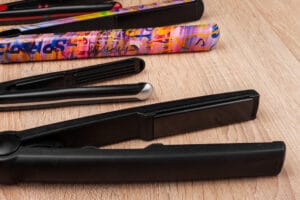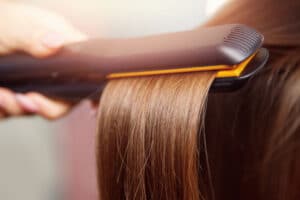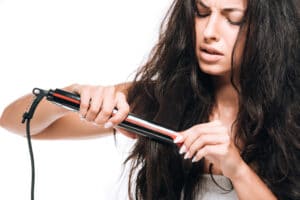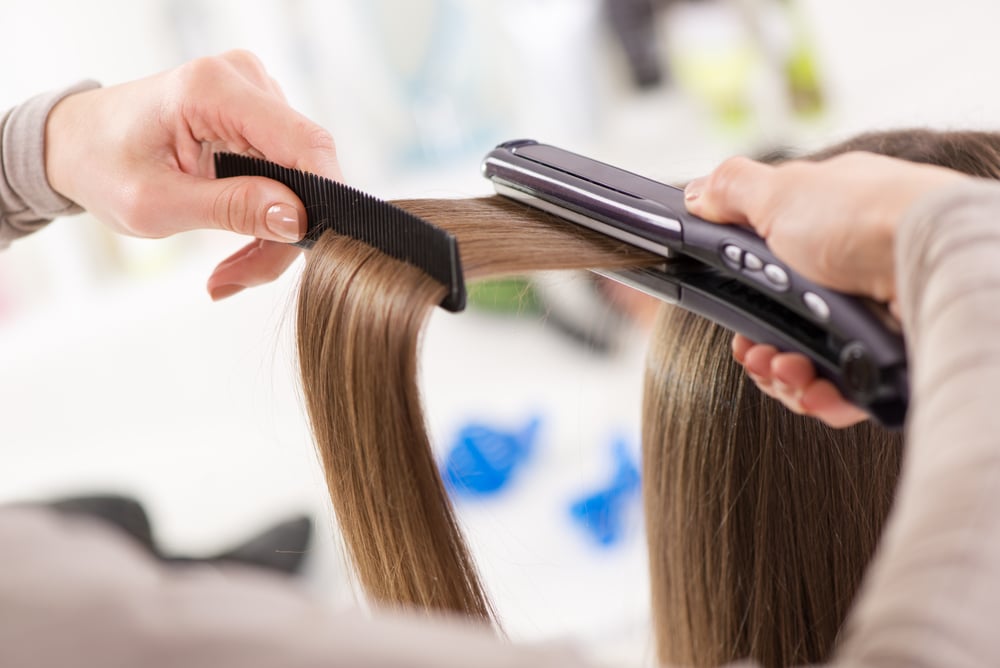Have you ever wondered about the history of modern hair products and styling tools? In particular, maybe you indulge in hair straightening and would like to learn about the evolution and history of modern hair tools.
In today’s article, we’ll be sharing an in-depth insight into when were hair straighteners invented and how hair straighteners have developed into the nifty tools we know today.
Hair Straightener Facts and Evolution
Hair straighteners are a regular part of people’s hair regime and allow you to achieve salon-worthy results from the comfort of your own home. How did they become the popular modern hair styling products that women can’t seem to live without?
Iron Rods
When were hair straighteners invented? It was in 1872 when French hairstylist named Marcel Grateau invented the first hair straightener in his Parisian salon. It was the late 19th century, a time when people were fascinated with women’s beauty, which is one of the reasons why he created a hair iron.
They must have some kind of device or something to straighten out. Like the Victorians did in the 19th century. For example: In 1872, Marcel Grateau (a Parisian) used heated rods to straighten or style hair.
Or in the Black Butler play OVA when Grell was styling his hair? pic.twitter.com/dNBsz3q6ff— Rena Nel #StayHome #SaveLives #StayAlive ???? (@rebel7heartsoul) June 16, 2019
The iron Grateau designed was meant to be used with various hairstyling creams. The idea was to apply the cream onto the locks before using the iron rods to straighten it. This tool had some flaws though; it’d often lead to heat-damaged hair follicles and could even burn your hair and scalp.
There’s some confusion that Erica Feldman was the creator of straightening irons, but she simply used the flat iron on her hair.
Hot Metal Combs
34 years after the first hair straightener was introduced, Simon E. Monroe created a technique for straight hair; combing locks with a hot metal comb. For straighter hair, the comb was heated via a warming agent. This would make it heated to result in a straight finish when you ran it through your hair. This technique meant you didn’t have to visit hair salons and was a kinder form of hair care.
Although the comb was perhaps a safer heated styling tool, it’d often take several hours for women to straighten their hair. There were even occasions where women would burn their hair and scalp.
Metal Plates
In 1909, metal plates were introduced by Isaac Shero. The hot plates on this straightener were designed to glide smoothly over the hair, minimising any damage. For further developments to the hair straightener, he then designed the electrical and ceramic straightener.
Over the years, Isaac K Shero continued to improve his design as he added various heat control settings on the tools for users to explore. The heat settings was one of the first safety features for minimal heat damage incorporated in the design of straightening tools.
Tongs With Hinged Metal Plates
Many women say that Scottish heiress Lady Jennifer Bell Schofield developed the first actual hair straighteners in 1912. Her hair styling tool contradicted everything that women knew about hairstyling as big curls were in fashion. Jennifer Bell loved straight hairstyles. So instead of developing a curling iron for women, she went against the norm.
Her tool consisted of two metal plates that woman during that time would warm up next to a fire and clamp onto hair to achieve a straighter hairstyle. If you take a look at online pictures, you can see that Lady Jennifer’s tong with attached heating plates did resemble a straightening iron.
Where Did Hair Straightening Originate?
Before straightening irons were invented, this trend of making hair straight had to come from somewhere. History shows us that straighter hair originated in Egypt where women had curly hair but wanted to play around with different hairstyles. In Egypt, the women used flat, hot iron plates as a hair straightener in the hope of a frizz-free style. Using iron plates would often cause burns and injuries to the scalp.
When Did Hair Straighteners Become Popular?
It wasn’t until the 1960s that is was considered fashionable to have straight hair and since then, the design of flat irons have evolved into the hair straighteners we know today. Before that, straight hair was considered unattractive by most women because wavy or curly hair was the trend.
The Development of Hot Plates
 Not everyone has the same hair type, which is why we’ve seen a significant development of the hair straightener throughout history. The technology surrounding hair straighteners has evolved so you can straighten your locks for the best look and minimal hair damage. Hence, you now have a range of straightener options to choose from.
Not everyone has the same hair type, which is why we’ve seen a significant development of the hair straightener throughout history. The technology surrounding hair straighteners has evolved so you can straighten your locks for the best look and minimal hair damage. Hence, you now have a range of straightener options to choose from.
Ceramic Plates
Using ceramic plates on straightening irons was one of the most popular technologies and is referred to as “ionic technology” or “far-infrared heating.” Ceramic plates warm the hair from the inside without damaging the hair’s exterior to result in less heat damage. This process increases moisture so you are left with a stunning shine without creating a coarse look. Furthermore, ionic technology uses negative ions to create a balance to the hair for smooth locks. It can even cut the straightening time down by half while looking twice as smooth as beforehand.
Titanium Plates
More recently, titanium plates have been developed for use on hair, giving birth to a new generation of straightening irons. Your hairdresser likely uses this material in their professional styling tools. Titanium plates can heat up to high temperatures very quickly, which is ideal if you’re in a rush. They glide over hair to create a smooth, shiny look, without requiring much skill or practice.
Best of all, titanium products work for every individual, no matter your hair type. If you have naturally curly hair, this might be the best type of hair straightener, especially as you can adjust the temperature control to suit your needs.
Furthermore, titanium plates are more durable and lightweight, enabling them to feel comfortable in your hands while using the flat iron.
Plate Width
 We’ve also seen different trends in the straightener size. In fact, you can opt for various widths, depending on your hair thickness and length. Therefore, you can choose a wider plate if you have long, thick locks or opt for a thinner hair iron if you’ll use the straightener on shorter, thinner hair.
We’ve also seen different trends in the straightener size. In fact, you can opt for various widths, depending on your hair thickness and length. Therefore, you can choose a wider plate if you have long, thick locks or opt for a thinner hair iron if you’ll use the straightener on shorter, thinner hair.
What’s more, hair straighteners are also an effective way to create different styles. Thus, depending on the size you go for, you may not be restricted to only straight hair.
Wet-to-Dry Hair Irons
Now, you are even able to straighten your hair as soon as you get out of the shower. This process encourages people to ditch the hair-drying stage and skip straight to styling. This fairly new concept reduces the risk of heat damage. You couldn’t use straighteners for dry hair on damp locks. Instead, wet-to-dry hair straighteners use a technology with a venting system that removes excess moisture from damp hair. This excess water is then converted into steam that’s then released back through the plates. As a result, the wet-to-dry tools retain your hair’s natural moisture without causing any damage.
Temperature Ranges
The modern flat iron comes with a range of temperatures to accommodate all types of hair. In fact, many straightening irons can reach a maximum temperature of 175 degrees, which is great for coarse or highly curled hair. But for thinner, damaged hair, applying less heat still lets you follow the latest trends without causing any damage.
View this post on Instagram
Heated Brushes
Simon E. Monroe developed the idea of using a comb as a hair straightener but this trend hasn’t fizzled out completely, as Sharon Rabi introduced the first hair straightening brush in 2015. Although these brushes may look like a typical brush, close up, they have plenty more features. For example, heated brushes are equipped with a heated plate on the bristles which allow the product to become warm once plugged into a mains.
The tips of the bristles are cool to touch, which reduces the chances of injuries and burns, and it can also be kinder on your hair than blow drying. But this product isn’t always suitable for people with dry, curly hair who require a higher heat for hair straightening.
Do Hair Straighteners Get Old?
 Hair straightening might be a big part of your beauty regime, but that doesn’t mean that flat irons will last forever—even if you look after them and follow the manufacturer’s care instructions. Below are some signs to upgrade your flat irons.
Hair straightening might be a big part of your beauty regime, but that doesn’t mean that flat irons will last forever—even if you look after them and follow the manufacturer’s care instructions. Below are some signs to upgrade your flat irons.
- The hair straightener feels coarse on your hair. This is primarily due to a build-up of hair products within the irons, which damages the plates, making users experience a rusty smell once they switch on the straighteners. Although you can easily wipe off these products with some dry tissue on cool hair straighteners, sometimes the substances can become burnt onto the plates, requiring a complete upgrade.
- Indicator lights are constantly flashing. Furthermore, another common way to tell that your hair irons are getting old is by the lights constantly flashing. This malfunction is often the result of overused hair straighteners. If your hair straighteners aren’t straightening your hair and you find that you constantly have to repeat the same section, the heating technology might have become broken. Although you may be able to get this professionally repaired, it might be worth renewing your tools so you can straighten hair without wasting time or money.
The Evolution of Hairstyles
Now that you know the answer to, “When were hair straighteners invented?” it is time to look into the evolution of hairstyles. Modern hairstyles appear completely different from trends beloved by preceding generations. From thick curls to sleek, long hair to the current voluptuous style, the hair world is constantly evolving.
With these changes, we’re seeing way more styling tools and products brought into the hair industry for people to utilise. In fact, you don’t just have to use straighteners for sleeker locks. There are lots of products available to curl, wave, and add lift to your hair using the right techniques.
What does your daily hair regime involve? And which hair straightener do you currently use? Let us know your thoughts and recommendations in the comments.
Additional Resources
- How to Use Hair Straighteners
- How to Straighten Hair Without Straighteners
- How to Curl Hair With Straighteners
Amy is a U.K.-based writer and editor with a penchant for helping consumers find the best home products for their needs, as well as providing easily digestible guides for living better at home. Her dedication to her work means she can usually be found elbow-deep in research or hunting down samples of the latest and greatest on behalf of her readers.
An avid DIYer herself, Amy’s passion lies in teaching others how they too can achieve their dream homes by tackling some of those pesky projects themselves! Whether it’s building furniture from scratch or turning an old dresser into a coffee table, Amy is always happy to share what she knows about making your house feel like home without spending a fortune.

